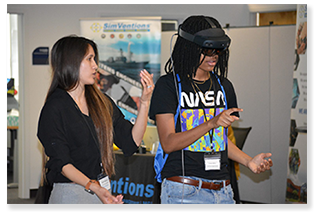Location
Virginia Modeling, Analysis and Simulation Center, Room 2100
Conference Title
Modeling, Simulation and Visualization Student Capstone Conference 2023
Conference Track
Visual Environments & Visualization
Document Type
Paper
Abstract
Maritime autonomy, specifically the use of autonomous and semi-autonomous maritime vessels, is a key enabling technology supporting a set of diverse and critical research areas, including coastal and environmental resilience, assessment of waterway health, ecosystem/asset monitoring and maritime port security. Critical to the safe, efficient and reliable operation of an autonomous maritime vessel is its ability to perceive on-the-fly the external environment through onboard sensors. In this paper, buoy detection for LiDAR images is explored by using several tools and techniques: machine learning methods, Unity Game Engine (herein referred to as Unity) simulation, and traditional image processing. The Unity Game Engine (herein referred to as Unity) simulation data was used for the training and testing of a Pointnet neural network model while the labeled real-world maritime environment point cloud data was used for the model validation. Fitting the Pointnet model on the simulation data, after some data alignment with the LiDAR images allowed for accurate classification of buoys on the real-world data with the 93% of accuracy. A traditional image processing approach using 2D occupancy maps to detect the buoys by shape was used as well and is outlined in the paper.
Keywords:
LiDAR, Point cloud, Machine learning, Pointnet
Start Date
4-20-2023
End Date
4-20-2023
Recommended Citation
Adolphi, Christopher; Parry, Dorothy Dorie; Li, Yaohang; Sosonkina, Masha; Saglam, Ahmet; and Papelis, Yiannis E., "LiDAR Buoy Detection for Autonomous Marine Vessel Using Pointnet Classification" (2023). Modeling, Simulation and Visualization Student Capstone Conference. 3.
https://digitalcommons.odu.edu/msvcapstone/2023/virtualandvisualization/3
DOI
10.25776/v27h-5z88
Included in
Artificial Intelligence and Robotics Commons, Computational Engineering Commons, Computer Engineering Commons, Remote Sensing Commons, Software Engineering Commons
LiDAR Buoy Detection for Autonomous Marine Vessel Using Pointnet Classification
Virginia Modeling, Analysis and Simulation Center, Room 2100
Maritime autonomy, specifically the use of autonomous and semi-autonomous maritime vessels, is a key enabling technology supporting a set of diverse and critical research areas, including coastal and environmental resilience, assessment of waterway health, ecosystem/asset monitoring and maritime port security. Critical to the safe, efficient and reliable operation of an autonomous maritime vessel is its ability to perceive on-the-fly the external environment through onboard sensors. In this paper, buoy detection for LiDAR images is explored by using several tools and techniques: machine learning methods, Unity Game Engine (herein referred to as Unity) simulation, and traditional image processing. The Unity Game Engine (herein referred to as Unity) simulation data was used for the training and testing of a Pointnet neural network model while the labeled real-world maritime environment point cloud data was used for the model validation. Fitting the Pointnet model on the simulation data, after some data alignment with the LiDAR images allowed for accurate classification of buoys on the real-world data with the 93% of accuracy. A traditional image processing approach using 2D occupancy maps to detect the buoys by shape was used as well and is outlined in the paper.


